|
Monday, May 1 Fengdu to
Chungqing
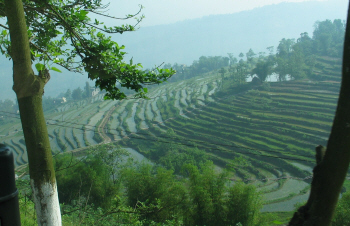 The first hour of our 3Ĺ hour
bus ride took us through the mountainous terrain and small villages on two-lane
roads to Fuling. We saw a lot of terraced rice paddies along the way as well as
homes whose entire flat roofs were tanks for raising fish. From that point on we
traveled on a very nice four-lane expressway through the countryside to
Chungqing. Chungqing is a very hilly city lying at the confluence of two rivers.
It is the largest and most populated of the our provincial-level municipalities in China
with 30 million inhabitants. Shanghai and
Beijing are the next two largest with 17 and 14 million people, resp. However,
over half of Chungqing's population live in the surrounding rural area.
About 12 million residents in the city proper makes it the 3rd largest city in
terms of population. In China,
they consider a city of less than one million people a small town. We arrived at the
Chungquing Carlton Hotel about noon where we had lunch. The first hour of our 3Ĺ hour
bus ride took us through the mountainous terrain and small villages on two-lane
roads to Fuling. We saw a lot of terraced rice paddies along the way as well as
homes whose entire flat roofs were tanks for raising fish. From that point on we
traveled on a very nice four-lane expressway through the countryside to
Chungqing. Chungqing is a very hilly city lying at the confluence of two rivers.
It is the largest and most populated of the our provincial-level municipalities in China
with 30 million inhabitants. Shanghai and
Beijing are the next two largest with 17 and 14 million people, resp. However,
over half of Chungqing's population live in the surrounding rural area.
About 12 million residents in the city proper makes it the 3rd largest city in
terms of population. In China,
they consider a city of less than one million people a small town. We arrived at the
Chungquing Carlton Hotel about noon where we had lunch.
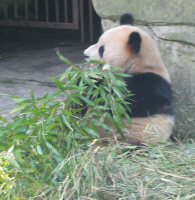 After lunch we were treated to
a brief visit to the zoo where we saw pandas and lesser pandas. We were
privileged to see two recent arrivals, a one-day-old orangutan and a 50-day-old
one. Because we spent the morning on the bus we didnít get to spend much time
at the zoo. It was pretty crowded anyway. This was the first day of Chinaís
Labor Day holiday which actually lasts an entire week. From there we went to the
Stilwell Museum, the former residence and offices of General Joseph
"Vinegar Joe" After lunch we were treated to
a brief visit to the zoo where we saw pandas and lesser pandas. We were
privileged to see two recent arrivals, a one-day-old orangutan and a 50-day-old
one. Because we spent the morning on the bus we didnít get to spend much time
at the zoo. It was pretty crowded anyway. This was the first day of Chinaís
Labor Day holiday which actually lasts an entire week. From there we went to the
Stilwell Museum, the former residence and offices of General Joseph
"Vinegar Joe" 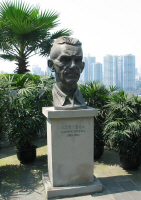 Stilwell, the commander of American forces in China,
Burma and India during the Second World War. Here we were told about the
colorful history of the American Volunteer Air Group called the "Flying
Tigers". Stilwell, the commander of American forces in China,
Burma and India during the Second World War. Here we were told about the
colorful history of the American Volunteer Air Group called the "Flying
Tigers".
Later that evening we were
transported to the airport again to catch a 6 pm China Eastern flight to Xian.
It was another very long and tiring day and by the time we got to our hotel we
were almost too pooped to eat. Since dinner was on our own, we ordered a
hamburger from the hotel dining room. Whether it was the hamburger or something
else -- Iíll probably never know -- but I woke up that night throwing up and
feeling pretty miserable again.
Tuesday, May 2 Xian
I still felt pretty bad in the
morning and food didn't sound or smell good to me. This was the day we were
scheduled to see Chinaís greatest archaeological attraction, the Qin
Mausoleum. More than 2000 years ago, the Emperor Qin Shi Huang was buried in an
earth mound here, along with 6,400 life-sized terra cotta warriors, archers, and
infantrymen, together with their horses and chariots, all individually sculpted
from live models. No visit to China would be complete without seeing this
astounding Terra Cotta Army and I was really worried I might not be up to it.
But I decided I had come this far and wasn't going to miss it.
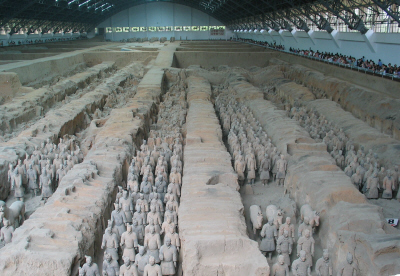 The warriors were accidentally
discovered in 1974 by a farmer digging a well. Since then, three large pits have
been uncovered so one can see an entire army, carved in incredible detail, and
standing in battle formation. I managed pretty well walking around and taking
pictures of the first and largest pit (172,000 sq ft now enclosed under one
roof) but fighting the crowds of people was too
much. Being there on a holiday and competing with Chinese tourists is definitely
not recommended. I finally gave up and hired someone to push me around in a
wheel chair. I was glad I did because it was a very long walk back to the bus. I
was in good company -- I think there were six in our group in wheel chairs.
James joked that his group consisted of the infantry brigade and the chariot
brigade. The warriors were accidentally
discovered in 1974 by a farmer digging a well. Since then, three large pits have
been uncovered so one can see an entire army, carved in incredible detail, and
standing in battle formation. I managed pretty well walking around and taking
pictures of the first and largest pit (172,000 sq ft now enclosed under one
roof) but fighting the crowds of people was too
much. Being there on a holiday and competing with Chinese tourists is definitely
not recommended. I finally gave up and hired someone to push me around in a
wheel chair. I was glad I did because it was a very long walk back to the bus. I
was in good company -- I think there were six in our group in wheel chairs.
James joked that his group consisted of the infantry brigade and the chariot
brigade.
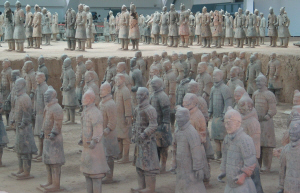
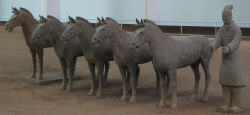
On our way back to the hotel we
stopped at a Chinese herbal store. Norma went in with the camera while I waited
and rested on the bus. Lunch was at a local restaurant where we saw a
demonstration on the preparation of the regionís famous noodles. In the
evening we signed up for the optional Tang Dynasty dinner and cultural show. It
was a very entertaining and impressive show with an orchestra playing unique
Chinese instruments and dancers in elaborate and beautiful costumes.
|  The first hour of our 3Ĺ hour
bus ride took us through the mountainous terrain and small villages on two-lane
roads to Fuling. We saw a lot of terraced rice paddies along the way as well as
homes whose entire flat roofs were tanks for raising fish. From that point on we
traveled on a very nice four-lane expressway through the countryside to
Chungqing. Chungqing is a very hilly city lying at the confluence of two rivers.
It is the largest and most populated of the our provincial-level municipalities in China
with 30 million inhabitants. Shanghai and
Beijing are the next two largest with 17 and 14 million people, resp. However,
over half of Chungqing's population live in the surrounding rural area.
About 12 million residents in the city proper makes it the 3rd largest city in
terms of population. In China,
they consider a city of less than one million people a small town. We arrived at the
Chungquing Carlton Hotel about noon where we had lunch.
The first hour of our 3Ĺ hour
bus ride took us through the mountainous terrain and small villages on two-lane
roads to Fuling. We saw a lot of terraced rice paddies along the way as well as
homes whose entire flat roofs were tanks for raising fish. From that point on we
traveled on a very nice four-lane expressway through the countryside to
Chungqing. Chungqing is a very hilly city lying at the confluence of two rivers.
It is the largest and most populated of the our provincial-level municipalities in China
with 30 million inhabitants. Shanghai and
Beijing are the next two largest with 17 and 14 million people, resp. However,
over half of Chungqing's population live in the surrounding rural area.
About 12 million residents in the city proper makes it the 3rd largest city in
terms of population. In China,
they consider a city of less than one million people a small town. We arrived at the
Chungquing Carlton Hotel about noon where we had lunch. After lunch we were treated to
a brief visit to the zoo where we saw pandas and lesser pandas. We were
privileged to see two recent arrivals, a one-day-old orangutan and a 50-day-old
one. Because we spent the morning on the bus we didnít get to spend much time
at the zoo. It was pretty crowded anyway. This was the first day of Chinaís
Labor Day holiday which actually lasts an entire week. From there we went to the
Stilwell Museum, the former residence and offices of General Joseph
"Vinegar Joe"
After lunch we were treated to
a brief visit to the zoo where we saw pandas and lesser pandas. We were
privileged to see two recent arrivals, a one-day-old orangutan and a 50-day-old
one. Because we spent the morning on the bus we didnít get to spend much time
at the zoo. It was pretty crowded anyway. This was the first day of Chinaís
Labor Day holiday which actually lasts an entire week. From there we went to the
Stilwell Museum, the former residence and offices of General Joseph
"Vinegar Joe"  Stilwell, the commander of American forces in China,
Burma and India during the Second World War. Here we were told about the
colorful history of the American Volunteer Air Group called the "Flying
Tigers".
Stilwell, the commander of American forces in China,
Burma and India during the Second World War. Here we were told about the
colorful history of the American Volunteer Air Group called the "Flying
Tigers". The warriors were accidentally
discovered in 1974 by a farmer digging a well. Since then, three large pits have
been uncovered so one can see an entire army, carved in incredible detail, and
standing in battle formation. I managed pretty well walking around and taking
pictures of the first and largest pit (172,000 sq ft now enclosed under one
roof) but fighting the crowds of people was too
much. Being there on a holiday and competing with Chinese tourists is definitely
not recommended. I finally gave up and hired someone to push me around in a
wheel chair. I was glad I did because it was a very long walk back to the bus. I
was in good company -- I think there were six in our group in wheel chairs.
James joked that his group consisted of the infantry brigade and the chariot
brigade.
The warriors were accidentally
discovered in 1974 by a farmer digging a well. Since then, three large pits have
been uncovered so one can see an entire army, carved in incredible detail, and
standing in battle formation. I managed pretty well walking around and taking
pictures of the first and largest pit (172,000 sq ft now enclosed under one
roof) but fighting the crowds of people was too
much. Being there on a holiday and competing with Chinese tourists is definitely
not recommended. I finally gave up and hired someone to push me around in a
wheel chair. I was glad I did because it was a very long walk back to the bus. I
was in good company -- I think there were six in our group in wheel chairs.
James joked that his group consisted of the infantry brigade and the chariot
brigade.
